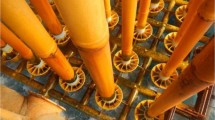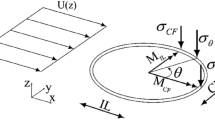Abstract
A simplified empirical model for fatigue analysis of deepwater marine risers due to vortex-induced vibration (VIV) in non-uniform current is presented. A simplified modal vibration equation is employed according to the characteristics of deepwater top tensioned risers. The response amplitude of each mode is determined by a balance between the energy feeding into the riser over the lock-in regions and the energy dissipated by the fluid damping over the remainder based on the data from self-excited oscillation and forced oscillation experiments of rigid cylinders. Multi-modal VIV fatigue loading is obtained by the square root of the sum of squares approach. Compared with previous works, this model can take fully account of the main intrinsic natures of VIV for low mass ratio structures on lock-in regions, added mass and nonlinear fluid damping. In addition, a closed form solution of fatigue damage is presented for the case of a riser with uniform mass and cross-section oscillating in a uniform flow. Fatigue analysis of a typical deepwater riser operating in Gulf of Mexico and West Africa shows that the current velocity profiles affect the riser’s fatigue life significantly and the most dangerous locations of the riser are also pointed out.
Similar content being viewed by others
References
Iwan W D. The vortex-induced oscillation of non-uniform structural systems [J]. Journal of Sound and Vibration, 1981, 79(2): 291–301.
Bokaian A. Lock-in prediction of marine risers and tethers [J]. Journal of Sound and Vibration, 1994, 175(5): 607–623.
Guo H Y, Fu Q, Lou M. Vortex-induced vibrations and fatigue life of marine risers conveying flowing fluid [J]. Engineering Mechanics, 2005, 22(4): 220–224 (in Chinese).
Pan Z Y, Cui W C, Miao Q M. A prediction model for vortex-induced vibration of slender marine risers [J]. Journal of Ship Mechanics, 2006, 10(3): 42–52.
Baarholm G S, Larsen C M, Lie H, et al. Simplified model for evaluation of fatigue from vortex induced vibrations of marine risers [C]//Proceedings of the 23rd International Conference on Offshore Mechanics and Arctic Engineering. Vancouver, Canada: [s.n.], 2004: 799–806.
Bokaian A. Natural frequencies of beams under tensile axial loads [J]. Journal of Sound and Vibration, 1990, 142(3): 481–498.
Sparks C P. Transverse modal vibrations of vertical tensioned risers: A simplified analytical approach [J]. Oil and Gas Science and Technology, 2002, 57(1): 71–86.
Govardhan R N, Williamson C H K. Modes of vortex formation and frequency response of a freely vibrating cylinder [J]. Journal of Fluid Mechanics, 2000, 420: 85–130.
De Wilde J J, Sworn A, Cook H, et al. Cross section VIV model test for novel riser geometries [C]//Proceedings of the16th Deep Offshore Technology Conference. New Orleans: [s.n.], 2004: 12–13.
Govardhan R N, Williamson C H K. Defining the ‘modified Griffin plot’ in vortex-induced vibration: Revealing the effect of Reynolds number using controlled damping [J]. Journal of Fluid Mechanics, 2006, 561:147–180.
Lyons G J, Patel M H. A prediction technique for vortex induced transverse response of marine risers and tethers [J]. Journal of Sound and Vibration, 1986, 111(3): 467–487.
Ge F, Hui L, Hong Y S. Vortex-induced vibration of submerged floating tunnel tethers in shear current [J]. Journal of the Graduate School of the Chinese Academy of Sciences, 2007, 24(3): 351–356 (in Chinese).
Venugopal M. Damping and response prediction of a flexible cylinder in a current [D]. USA: Department of Ocean Engineering, MIT, 1996.
Chaplin J R, Bearman P W, Huera huarte F J, et al. Laboratory measurements of vortex-induced vibrations of a vertical tension riser in a stepped current [J]. Journal of Fluids and Structures, 2005, 21(Sup 1):3–24.
Chaplin J R, Bearman P W, Cheng Y, et al. Blind predictions of laboratory measurements of vortex-induced vibrations of a tension riser [J]. Journal of Fluids and Structures, 2005, 21(Sup 1): 25–40.
The group for typical deep water platform conceptual design. The design method for typical deep water top tension risers [J]. Shipbuilding of China, 2005, 46(Sup):447–452 (in Chinese).
Thethi R, Howells H, Natarajan S, et al. A fatigue monitoring strategy & implementation on a deepwater top tensioned riser [C]//Proceedings of the Annual Offshore Technology Conference. Houston, USA: [s.n.], 2005: 17248.
DNV-RP-C203, Fatigue design of offshore steel structures [S].
Author information
Authors and Affiliations
Corresponding author
Additional information
Foundation item: the National High Technology Research and Development Program (863) of China (No. 2006AA09A107)
Rights and permissions
About this article
Cite this article
Xue, Hx., Tang, Wy. & Zhang, Sk. Simplified model for evaluation of VIV-induced fatigue damage of deepwater marine risers. J. Shanghai Jiaotong Univ. (Sci.) 14, 435–442 (2009). https://doi.org/10.1007/s12204-009-0435-2
Received:
Published:
Issue Date:
DOI: https://doi.org/10.1007/s12204-009-0435-2




